Site Menu:
| This is an archived Horseadvice.com Discussion. The parent article and menus are available on the navigation menu below: |
| HorseAdvice.com » Training & Conditioning Horses » Tack and Training » Types of Saddles and Fitting » |
| Discussion on Bareback Pad and White Hairs Forming | |
| Author | Message |
| Member: lsweeney |
Posted on Monday, Feb 2, 2009 - 6:05 pm: O.K. I'm flipping out. I own a young Friesian mare, and she is starting to shed out from the winter. There are spots on her back and sides that are pretty much in the shape of my rearend that are turning white. Pretty large patches.I have not taken her to her keuring, and I'm afraid the judges are not going to let her into the studbook because Friesians are supposed to be black! I am a very infrequent, weekend rider, and I had a lot going on with my business last year, so we did not ride much. When I ride, I ride her in a fluffy bareback pad, no stirrups. I have ridden this way for years, and we are both round and comfortable. We mostly walk on the trail. So easy relaxed riding. No long distances - usually 5 miles max. I have excellent balance, so I use my inner thighs the most to stick on. This mare is not a HOT high strung animal. We did have one 3 day weekend in the fall where we rode on the beach on the California Coast where we rode several miles everyday for about 3 days straight, with one day where we rode maybe 10 to 15 miles up and down hill. I do remember the horses working hard and sweating. We have had iffy weather and muddy trails so for the last couple of months I have just taken her out walking her in hand - so no riding. She is out in a 3 acre pasture so she is not stalled. She has a LOT of hair for a Friesian mare. During the winter it isn't unusual for her to have a 6-7 inch beard under her chin. I have ridden other horses through the years much harder and longer bareback and never have seen anything like this. I did notice one speck of white on her face too. She will be 5 in June 09. So it is not age. So, I have heard that bareback can be harder on the back because the weight is not being spread out. So that is one thing to consider. I don't know if heat is an issue given her coat and a fluffy bareback pad? I am not a tiny person 190 lbs, so my weight might come into play - but I'm not as large as a big man either - and I'm not on a small horse. I could by into this as just saddle sores, but it is so weird given how little I have ridden the horse, compared to someone who is riding every day or several times a week. Do you think this is permanent? And is there anything I can do to fix the white hairs other than Loreal? Thoughts? |
| Member: mrose |
Posted on Monday, Feb 2, 2009 - 9:59 pm: Has the skin under the hair lost it's pigmentation? |
| Member: hollyw |
Posted on Monday, Feb 2, 2009 - 10:09 pm: Laurie, do you have a digital camera so you can post a photo? |
| Moderator: DrO |
Posted on Tuesday, Feb 3, 2009 - 6:46 am: "Turning white" can mean many things so I too would like to see a really good image of this. Be sure the lighting is behind you and work for close ups and whole body shots are in good focus.Though the pattern suggests pressure may be involved I agree with you that the history you give makes it unlikely but checking for depigmentation as Sara suggests is a good first step. Depigmentation in the skin indicates permanence. DrO |
| Member: lsweeney |
Posted on Tuesday, Feb 3, 2009 - 2:26 pm: I'll get pictures. |
| Member: lsweeney |
Posted on Tuesday, Feb 3, 2009 - 9:42 pm: Here you can see the vague salt and pepper look. It is the same on both sides, and I'm sure is where my thighs hit her back.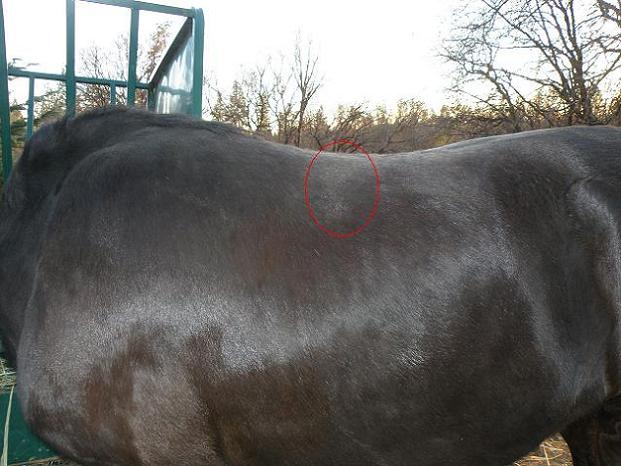
|
| Member: lsweeney |
Posted on Tuesday, Feb 3, 2009 - 9:47 pm: I tried to point the camera down across the top of her back. She has some salt and pepper across the back with the most hair where the thighs would hits her.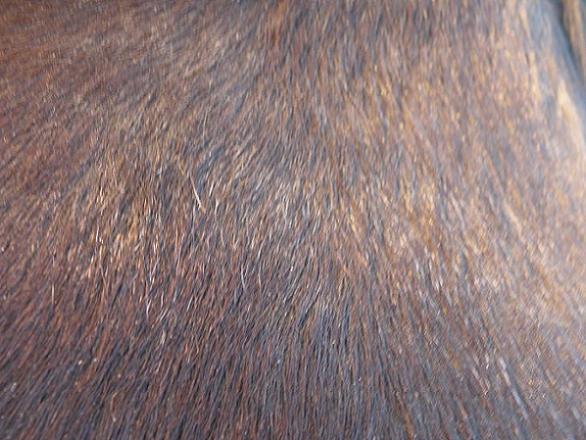
|
| Member: lsweeney |
Posted on Tuesday, Feb 3, 2009 - 9:52 pm: Much more dramatic when you thumb the hair.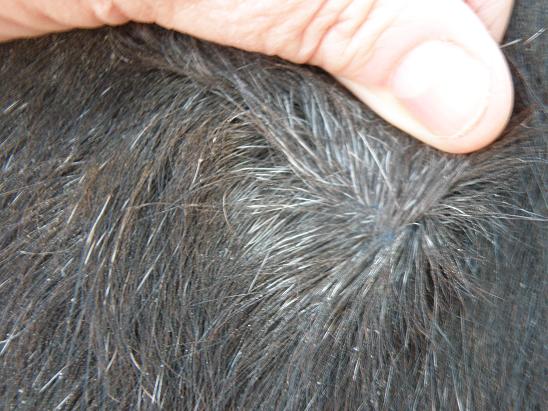
|
| Member: terrido |
Posted on Tuesday, Feb 3, 2009 - 9:52 pm: Laurie (HI!) Dr O and Sara are right if the skin pigmentation has changed that will say alot.It could be from any number of reasons, but yes heat can be a factor. Hmmm if she is out of shape, (from not being worked regularly) may also be lack of muscle tone, which could lead to a circulatory issue. I doubt the judges will mark you down for the white, as long as they look like 'scars' and you can obtain a statement from your Vet. Most judges I have spoken with don't care so much about the color of the horse as long as it's not an obvious "white" as in having a white front foot or something. They are interested in conformation and movement. What I can tell you is to not try to hide it with dye or anything if you do take her to keuring. Some horses just 'grey' earlier than others too. This pattern does look much like where you would be sitting.... Try a well fitting saddle for a while and see if this changes maybe? |
| Member: lsweeney |
Posted on Tuesday, Feb 3, 2009 - 9:54 pm: One more of the hair underneath.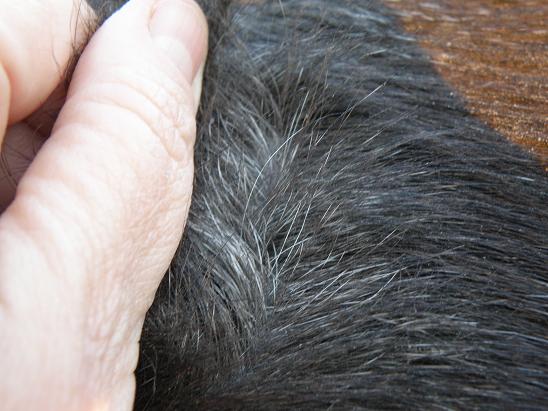
|
| Member: lsweeney |
Posted on Tuesday, Feb 3, 2009 - 10:18 pm: Here is a full picture of her. She doesn't have any other white on her.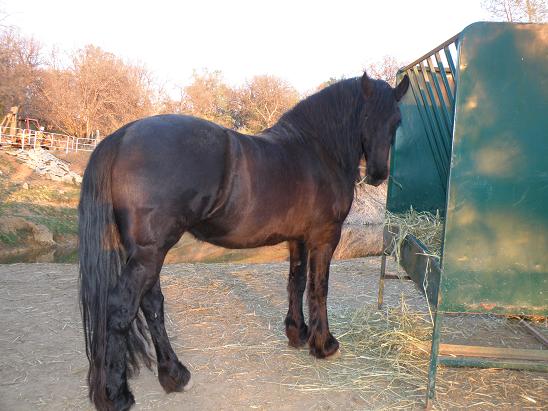
|
| Member: lsweeney |
Posted on Tuesday, Feb 3, 2009 - 10:25 pm: Here is a picture from 10/08 - No white.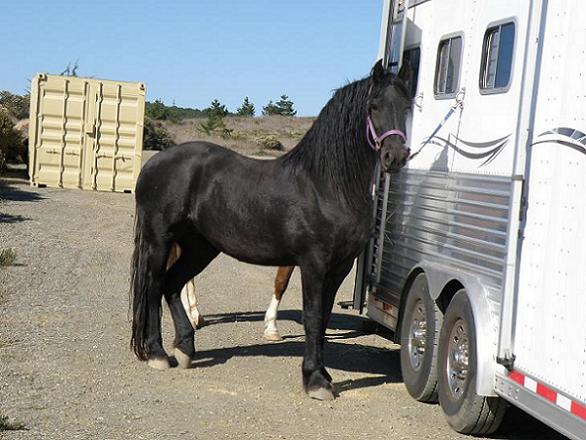
|
| Member: lsweeney |
Posted on Tuesday, Feb 3, 2009 - 10:29 pm: Finally, what I was riding in.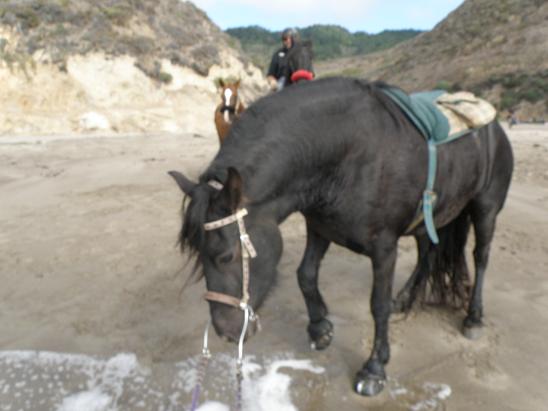
|
| Member: terrido |
Posted on Tuesday, Feb 3, 2009 - 10:45 pm: Pretty girl!Skin appears to be dark underneath... ok I am at a loss, other than possibly a circulatory thing happening. Hope Dr O can give you a better idea of what may be causing the white hair. Course, other than the possibility of the usual cause being 'pinching' lack of circulation, etc. it is just hair. ;) I mean she is still a beautiful girl. My friesian mare bleaches to a nice dark bay in the summer and she's managed to remove the lower half of her (was at her knees!) mane, so she now sports a much shorter mane. But to me she is still beautiful even when she isn't jet black (like now cause it's winter) and she doesn't have that dreamy mane. It is after all just hair. LOL Yup we friesian people do love our hairy ponies! What are her lines?? I love her sweet face, looks alot like Wander... or even Wicher. My mare is a Wicher daughter. |
| Member: mrose |
Posted on Tuesday, Feb 3, 2009 - 11:13 pm: I agree with Terrie, she is a cutie; I love her face! Since her skin is still dark, I think chances are good that her hair will grow back in dark again. But, it is weird looking. Maybe someone else or Dr. O. will have more to say and better advice. btw, I'm totally jealous! You are riding on the beach!!! Wow! |
| Member: lsweeney |
Posted on Tuesday, Feb 3, 2009 - 11:22 pm: Thanks Terrie for the calming words.I'm not really seeing loss of pigmentation in the skin. |
| Member: lsweeney |
Posted on Tuesday, Feb 3, 2009 - 11:48 pm: I really liked Wicher. I felt very bad when he passed. Died of the same thing that my older Arab did.Her breeding is Tsjalke and Gerlof on the bottom. |
| Member: lsweeney |
Posted on Wednesday, Feb 4, 2009 - 12:22 am: Thanks for the complements. Myntje had a dim view of the beach initially. In the above picture she was just starting to figure out that it was wet and cool, and maybe not that bad after all.What I remember is that it ended up being a nice day, and it was hot. So I've been thinking anywhere from too hot under that pad, to too much time riding bareback with pressure in one spot. |
| Moderator: DrO |
Posted on Wednesday, Feb 4, 2009 - 7:22 am: Thanks for the photos Laurie, I have seen this kind of "roany" look come and go on chestnut, bay, and black horses. Unfortunately I have also seen horses as they age roan-in in patches permanently. I am surprised to see it in a Freisian however the amount of trauma to the area does not explain it either. I think we will have to wait to see how this goes. If this is really bothersome to you you might consider switching to a very light well fitting saddle to see if a difference is made.I almost hate to mention this but some have recommended paprika supplementation to "blacken" horses. The use is a little different than your problem however as it is meant to keep black horses from fading in the sun. There is no scientific evidence any of this works however. DrO |
| Member: ekaufman |
Posted on Wednesday, Feb 4, 2009 - 9:58 am: Hi Laurie,Just a question-- I realize you're questioning whether it's rider pressure, but looking at your rigging (as much as I can from the angle), could it be the pressure from the girth? Bareback pads don't have any means to distribute that, and it looks like the girth may cross exactly over the graying areas? |
| Member: lsweeney |
Posted on Wednesday, Feb 4, 2009 - 1:56 pm: Yes, Elk, that has also crossed my mind. I could also find discussions on the internet where they said not to use stirrups with a bareback pad for the same reason.Dr. O, Thank you for your thoughts. I might be able to buy into some roaning thing, but the fact that this looks like my rearend superimposed on her back, it has to be riding related - whether it be pressure, heat, bacterial from sweat? Something relating to riding. And maybe she does have some unique vulnerability that is in play? Because, truly I have not been living on this horse's back. Honestly, other than this long weekend of heavier riding in Pt. Reyes, I have probably been on her a handful of times after that, which was 10/08 where she was ALL black. I agree that since this is probably no a wrist slitting illness (I'm calming down.... ;-) ), we will have to take a look and see attitude. I think my only other choice is to see if I can find a saddle that might spread the weight around more evenly. Thank you for everyone's thoughts, and I will keep you posted when we completely shed out. |
| Member: shanson |
Posted on Wednesday, Feb 4, 2009 - 6:03 pm: This seems similar to an incident I had with my mare. I started noticing some white hair appearing in the saddle area as she shed out one year. It looked like damage from saddle pressure, even though her saddle was a good fit. My saddle fitter look at it and turned out the tree had cracked a bit, unnoticeable to me, but creating a slight pressure point.I worried a lot that the damage might be permanent, but within 6 months or so to my relief the white hairs disappeared. |
| Member: lsweeney |
Posted on Wednesday, Feb 4, 2009 - 7:12 pm: Sharon - Wonderful news that I will hang on!Thank you! Laurie |
| Member: terrido |
Posted on Saturday, Feb 7, 2009 - 1:21 pm: Laurie, I think a wait and see is in order here.But, for at least the next 6 months if you do ride I would ride in a well fitting saddle and not hop on bareback. Give her back time... Dr O's suggestion of paprika to help her darken is sound. Just be cautious of the amount and do not give if you will be doing any showing. You can also use black sunflower seed oil. I am pretty sure you are a member of the big 'friesians' list, check the archives on the group site. There's loads of info on darkening, preventing bleaching out, etc. I think our smaller NorCalFriesians list also has some info. ;) But overall I would just stay off her back and see what happens by summer as the new coat comes in. Keep us informed!! She is very pretty, must be the Gerlof in her I see. Yes, I was very sad when Wicher passed as well, sorry to hear you experienced the same type of loss. Very sad. (Genevieve's passing was just as sad.) There is also lots of keuring info, preparation, what the judges look for, etc. in the groups archives. Have fun researching! |
| Moderator: DrO |
Posted on Saturday, Feb 7, 2009 - 9:57 pm: Terri, just so we are clear this is not a "sound" recommendation but a act of desperation. I do not know of one scientific principle that this will be effective. But do not know of anything else that might be.DrO |
| Member: terrido |
Posted on Wednesday, Feb 18, 2009 - 9:13 am:  Clear DrO. No worries. I have quite a few friends that have used paprika or products containing it, and their horses have had nice results with coat darkening and remaining dark through summer. But as I understand it if you compete it is not a desirable thing to be found in the horse's blood. Clear DrO. No worries. I have quite a few friends that have used paprika or products containing it, and their horses have had nice results with coat darkening and remaining dark through summer. But as I understand it if you compete it is not a desirable thing to be found in the horse's blood. Laurie will just have to keep us posted. |
| Member: lsweeney |
Posted on Saturday, Feb 28, 2009 - 1:53 pm: I thought you guys might be interested in some pictures of her hair. Pretty weird. The roots are at the top. The ones on the right have white at the roots. The ones I'm more interested in are the ones that go black white black.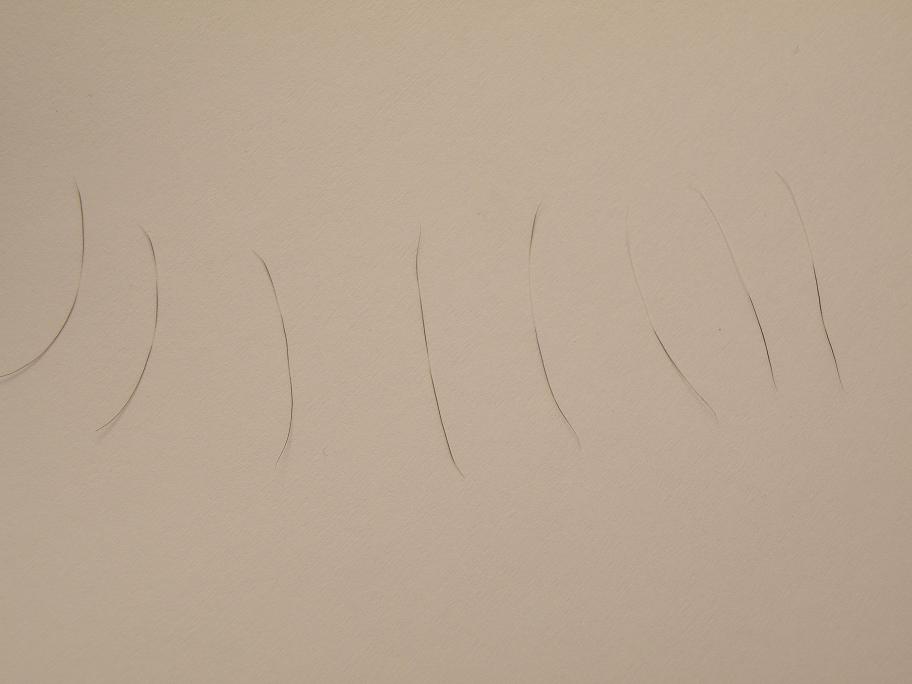
|
| Member: lsweeney |
Posted on Saturday, Feb 28, 2009 - 2:17 pm: Here's a close up.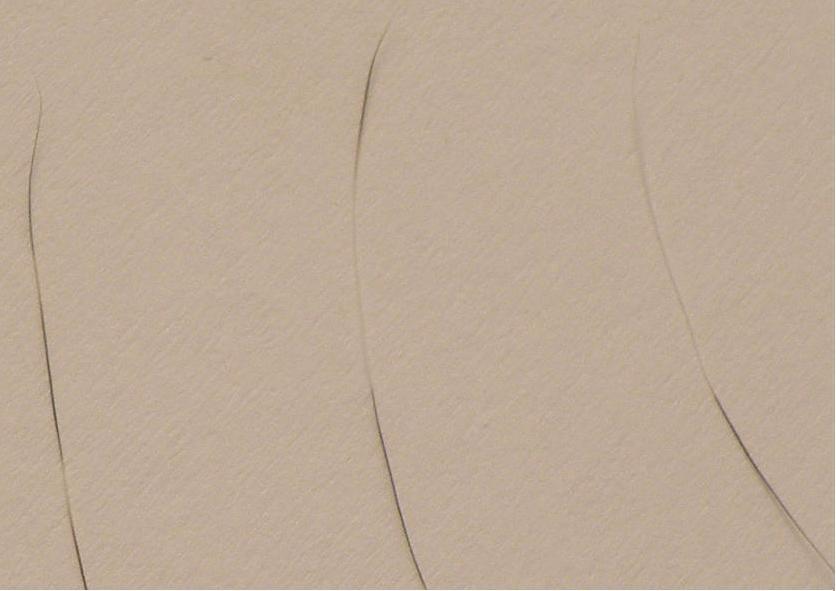
|
| Member: hollyw |
Posted on Saturday, Feb 28, 2009 - 2:34 pm: Oh, my gosh!!! She's going to be striped or polkadotted . . . or maybe checkerboarded? Very strange.I have a half-draft with white spots behind his withers from a dude ranch saddle that pinched him for years . . . but I'm pretty sure his hairs aren't striped like that. |
| Moderator: DrO |
Posted on Sunday, Mar 1, 2009 - 10:12 am: Great pictures Laurie,Here is a fact: the melanocytes turned off during the white growth phase then turned back on during the pigmented growth. Using the history and pattern I would hypothesize that pressure related stress caused it. DrO |
| Member: lsweeney |
Posted on Wednesday, Mar 4, 2009 - 5:12 pm: I thought you guys might find those hairs a little interesting. It looks like we are getting a consensus based on your comments and the ones below:I spoke with the owner for Skito pads. He says that the white pattern is very typical of thigh pressure, and speaks to how I ride and where the pressure points are. This is also compounded by how round and wide she is. It probably wouldn't be as big of a deal with a narrower horse. He is going to custom make me a pad that is going to try to mitigate the thigh pressure that I will put on under my other pad. He says that I'm not going to get away from the pressure with a treeless saddle, and ultimately, my only other option will be to go with a treed saddle. He also said that my riding pattern is impacting the situation as well. He said that an endurance rider is flying along, and actually doesn't generate pressure in one spot that long. However, with me just poking along for hours, actually is putting more pressure in one spot for a longer period of time. So I am thinking that I'm riding easy on the horse, but in the end, may be having more impact sitting in one spot for an extended period. He also said to put baby powder on the horse's back and then note where it sweats into the pad to determine the pressure points. |
| Member: ekaufman |
Posted on Wednesday, Mar 4, 2009 - 7:03 pm: FWIW Laurie, I rode my old horse in a treeless Ansur on one of those computerized saddle pads that recorded pressure patterns, and it distributed my weight very well, and much better than the bareback riggings in the same clinic. Honestly we were all surprised how well it compared to some pretty fancy treed saddles. Your mileage may vary.- elk |
| Member: lsweeney |
Posted on Wednesday, Mar 4, 2009 - 10:52 pm: I'm not done Elk. I have a feeling that this will be a work in progress. What I'm thrilled about is that there are an awful lot of options out there that sure didn't exist in the past.So I may do both. Look at some saddle options and a more padded option for bareback. This fix is pretty cheap and simple. I like that. But my feeling is that this might not be the final solution or only solution. |
| Member: ajudson1 |
Posted on Thursday, Mar 5, 2009 - 6:49 pm: I ride in a treeless saddle, and I've never noticed an uneven sweat pattern, at least not one different from a treed saddle. Interesting point, and I think I will check it out more with the baby powder tip. IF we ever get rid of all this dang snow!Laurie, Just wondering if you are familiar with the Skito Pads? I have one and don't like it. It is very hard in my opinion. If you get one, and keep it clean using it, he will take it back if you change your mind. |
| Member: lsweeney |
Posted on Thursday, Nov 5, 2009 - 11:20 pm: I thought I would update this. I spent untold hours reviewing treeless saddles and various bareback options. I wanted to retain my close contact that I get from riding bareback. Also, the simplicity. I found that a lot of people with round horses like mine had experiences with the treeless saddles rolling. So now you are looking at breast collars, tight cinching and a crupper to hold the saddle in place. I got a taste of this instability with my bareback pad over a Skito pad with extra inserts where my thighs were. My thighs could not get that tight grip around her, and I was moving around. I solved this my using a Thinline pad which held the Skito pad in place.However, my ultimate solution was an Equalizer Bareback pad from the Australian Stock Saddle Company. https://www.aussiesaddle.com/bareback_pad.html I ordered it in black sheepskin, and it looks really sharp with my black Friesian. It has D rings all around. The cinching system is much better than a normal bareback pad and attaches in a way that I don't think I have a narrow pressure point going over the back. I can feel the plastic in the pad which does a better job of distributing the weight, and yet doesn't sacrifice the close contact with the horse. The extra padding where my seat and thighs goes does not cut into me or the horse like my other solution. I put my Thinline pad underneath to protect the bareback pad as well as stick to the horse, and I feel totally solid with this. So I have a solution that does a better job of spreading my weight around, and yet isn't a major departure from my 30 years of bareback riding. I'm VERY happy. I'll try to get a picture and post it. |
is The Horseman's Advisor
Helping Thousands of Equestrians, Farriers, and Veterinarians Every Day
All rights reserved, © 1997 -
